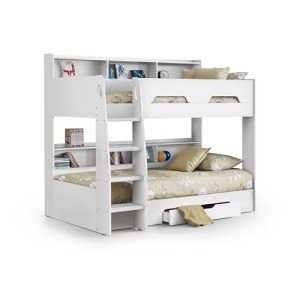The Bunk Beds Awards: The Most, Worst, And Weirdest Things We've Ever Seen

Exploring Bunk Beds: A Comprehensive Guide
Bunk beds have actually long been a staple in kids's bedrooms, dorms, and even homes with minimal space. Not only do they offer a practical sleeping option, however they also produce an enjoyable and creative environment for kids and a great space-saver for adults and households. This article will check out whatever you need to learn about bunk beds, from types and products to safety ideas and buying recommendations.
Table of Contents
- Kinds Of Bunk Beds
- Traditional Bunk Beds
- Loft Beds
- Triple Bunk Beds
- L-Shaped Bunk Beds
- Product Options
- Wood
- Metal
- Security Considerations
- Purchasing Guide
- Frequently asked questions
Types of Bunk Beds
Bunk beds can be found in different designs to match various needs and choices. Here's a breakdown of the most common types:
Conventional Bunk Beds
Traditional bunks generally feature 2 beds stacked vertically on top of one another. These beds are ideal for brother or sisters sharing a space or for making the most of sleeping space in guest spaces.
Loft Beds
Loft beds stand likewise to conventional bunk beds however do not have a lower sleeping area. Instead, they typically include a desk or seating area underneath, making them a great choice for small spaces requiring multifunctionality.
Triple Bunk Beds
Triple bunk beds are developed for 3 residents, with beds stacked in a three-tier setup. These are less common but can be a fun service for big households or slumber parties.
L-Shaped Bunk Beds
With one bed placed horizontally and the other vertically, L-shaped bunk beds are often geared up with additional features such as desks or storage drawers and can match corner spaces in a room.
Contrast of Bunk Bed Types
| Bed Type | Ideal Use | Description |
|---|---|---|
| Standard | Shared bed rooms or guest spaces | 2 beds stacked vertically |
| Loft | Little rooms needing multi-purpose space | Upper bed with open space underneath |
| Triple | Large families or pajama parties | Three beds stacked vertically |
| L-Shaped | Corner or versatile spaces | A mix of vertical and horizontal beds |
Product Options
Bunk beds are manufactured from various products, with wood and metal being the most common. Each material has its advantages and disadvantages.
Wood
- Toughness: Generally robust and can stand up to years of use.
- Visual Appeal: Offers a timeless look that can blend with various decors.
- Weight Capacity: Typically tougher; can support much heavier weights.
- Downsides: May be more expensive than metal alternatives and can be vulnerable to scratches.
Metal
- Sturdiness: Generally lightweight and easy to move but still tough.
- Modern Design: Often comes in smooth designs, making it appealing for contemporary areas.
- Affordable: Usually less costly than wood choices.
- Downsides: Can be cold to the touch in winter seasons and may not have the exact same aesthetic appeal for some buyers.
Security Considerations
When it pertains to bunk beds, security can not be neglected. Here are crucial security suggestions to keep in mind:
- Guardrails: Ensure that the leading bunk has guardrails on both sides to prevent falls.
- Tough Construction: Check for a solid develop and tough products to hold up against weight and movement.
- Weight Limit: Adhere to the maker's weight limit for both the upper and lower bunks.
- Ladder Design: Choose bunks with a safe, easy-to-climb ladder and prevent any sharp edges or rungs.
- Age Restrictions: Most makers advise that kids under the age of six need to not oversleep the upper bunk.
Purchasing Guide
When looking for bunk beds, think about the following factors to find the very best suitable for your needs:
- Space Availability: Measure the room size and ceiling height, making sure there is appropriate space for the top bunk.
- Bed Size: Decide in between twin, complete, or bigger sizes based on your needs and the size of the space.
- Style Preference: Consider the total decor of the bedroom to discover an ideal style.
- Alleviate of Setup: Look for a bunk bed that is uncomplicated to assemble.
- Spending plan: Bunk beds can be found in various price ranges, so determine a spending plan before beginning your search.
FAQs
1. What is the suggested age for kids to sleep on the top bunk?
Kids aged 6 and older are usually recommended to sleep on the leading bunk to lessen the risk of falls.
2. How can I make my bunk bed more secure?
To boost security, guarantee guardrails are properly set up and examine that the bed is positioned on a flat surface area. Furthermore, motivate children to use the ladder thoroughly.
3. Can I convert a bunk bed into two separate beds?
Numerous bunk beds are developed to be convertible. Examine the manufacturer's requirements for convertibility functions.
4. What devices are readily available for bunk beds?
Common accessories consist of bed linens, storage drawers, staircases instead of ladders, and tented canopies for a fun visual appeal.
5. How do I preserve my bunk bed?
Regular look for loose screws or structural stability can assist make sure security. Dust the bed regularly and tidy spills immediately to keep the products in good condition.
Bunk beds are flexible and a space-efficient service for various living situations, from kids's spaces to guest lodgings. With many styles and materials offered, potential purchasers have a wealth of choices to think about, guaranteeing a combination of usefulness and aesthetics. By focusing on linked web-site and following the suggestions outlined in this guide, individuals can discover the ideal bunk bed that suits their space and way of life, all while creating an enjoyable sleeping environment.

